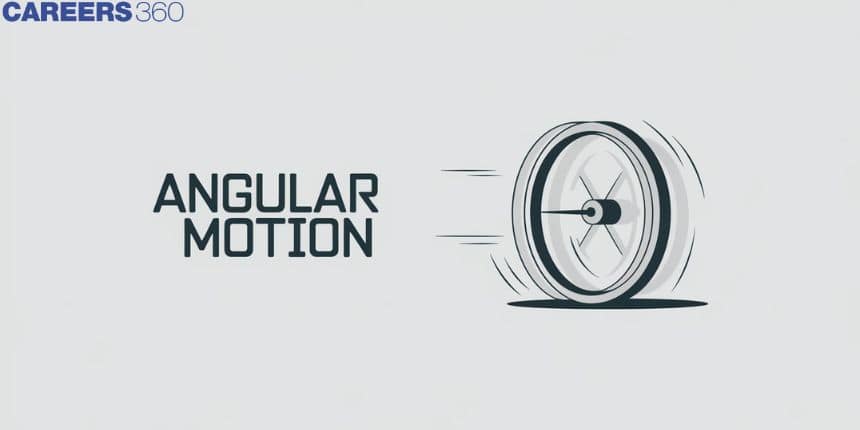Angular Motion – Definition, Types, Explanation and FAQs
Angular Motion - The calculation of linear velocity, translation, and angular momentum can all be done using a variety of equivalent formulas found in physics. The connection between angular and linear motion will be covered in this section. The body moves in an angular motion when it follows a curved line with a constant and even angular velocity. An illustration might be a runner moving along a circular course or a car navigating a curve. Measuring centrifugal forces and knowing how they affect the motion of the object is one of the frequent problems encountered here.
This Story also Contains
- What Does Mean by Angular Motion?
- Angular and Linear Motion Relationship
- Formulas that allow for angular and linear motion.
- Different angular motion types and explanations
- In a circular motion, is angular velocity constant?

What Does Mean by Angular Motion?
The angular motion refers to the movement of an object around a fixed point, such as a pivot or axis. This type of motion is also known as rotational motion, and it involves a change in the orientation of an object rather than a change in its position.
Angular and Linear Motion Relationship
You can obtain the angular motion formulas by substituting the following variables:
Acceleration: We use the letter "a" to signify linear acceleration and the symbol "α" to signify rotational acceleration. Radians per second is the unit used to measure rotational acceleration.
Displacement: In linear motion, we measure the straight distance travelled with the letter "s." The angular distance in angular motion is expressed using the symbol "θ" which is measured in radians.
Velocity: In linear motion, the letter "v" is used to represent speed; in angular motion, the symbol "ω" is used to represent angular speed. The number of radians travelled per second is known as angular velocity.
Formulas that allow for angular and linear motion.
Formulas | Angular | Linear motion |
Displacement | \theta ={{w}_{i}}t\,+\,\frac{1}{2}a{{t}^{2}} | s={{v}_{i}}t\,+\,\frac{1}{2}a{{t}^{2}} |
Velocity | \omega =\frac{\Delta \theta }{\Delta t} | v=\frac{\Delta s}{\Delta t} |
motion that is cancelled by time | \mathop{\omega }_{f}^{2}-\mathop{\omega }_{i}^{2}=2a\theta | \mathop{v}_{f}^{2}-\mathop{v}_{i}^{2}=2as |
Acceleration | a=\frac{\Delta \omega }{\Delta t} | a=\frac{\Delta v}{\Delta t} |
Different angular motion types and explanations
Things That Are Three Dimensional
We once more have the r-dimensional position and velocity of a moving molecule in the three-dimensional particle space. In this case, the rule of the right hand is not applied because there are two distinct ways that are inherently perpendicular to any plane, so an additional condition is required to identify the path of the angular velocity in a unique way.
For the rigid body, the angular velocity vector
The variables of all three must have the same rotation velocity at each location if you have a revolving frame with three unit vectors. Each vector in such frames can be thought of as a travelling particle with a fixed scalar radius. The rotating frame frequently occurs in the setting of rigid bodies, and for this, specialised customized tools have been created.
In a circular motion, is angular velocity constant?
In order to continue travelling in a circle while growing at a steady speed, an item must experience linear greater velocity. Since the angular velocity sweeps out the same constant arc length every time, it is regarded as constant. The circular path motion can be described as the constant angular velocity in the circle. Therefore, an item travelling in a circle has a fixed angular velocity.
Frequently Asked Questions (FAQs)
When forces occur on stretched items, they can also modify the motion of the item in its spin in addition to its rotational movement. In other words, these forces may result in acceleration of translation or acceleration of angular motion.
In physics, the rotational velocity (ω), also referred to as the angular frequency vector, is a pseudovector description of how frequently an object's angular position or orientation varies over time.
The attribute of any rotating object determined by the product of the moment of inertia and the angular velocity is known as angular momentum. It is a characteristic of rotating bodies that is determined by the sum of their moment of inertia and angular velocity.
Since angular velocity is a vector, it has a magnitude and a direction. The angular velocity vector will typically be represented in this curriculum by the symbol or the magnitude of the axis indicates the rotational speed, expressed in radians per second.
While torque is determined by the amount of force needed to turn an item, angular momentum is defined as the angle between the line of the force of action and the point of rotation. Angular Momentum is not employed in these situations because the coupling is also calculated using torque alternatively.